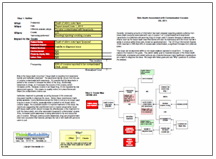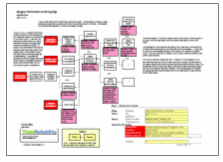By Kim Smiley
Sometimes, what seems like a very simple, easy solution turns out to be much more complicated. Unless a system is very well understood, implementing a solution can have unintended consequences. Take for example, the changes made to playgrounds over the past couple of decades. There was concern that children were being injured while playing, especially from falls from high playground equipment. Removing any playground equipment that was deemed dangerous seemed like an obvious solution to this problem.
Gone are the metal merry-go-rounds and the ten feet tall monkey bars that many of us remember from our youth. Modern playgrounds are populated by lower, enclosed platforms and soft ground coverings to prevent injuries and protect against lawsuits.
But are modern playgrounds better? According to a recent New York Times article , the answer isn’t the slam dunk you might expect. There is mixed evidence about whether modern playgrounds actually reduce the number of injuries because children tend to take more risks on “safer” playgrounds. There is also evidence that the value of playgrounds in childhood development might have been diminished by the increased focus on safety.
 A recent paper by Norwegian scientists discusses the value of allowing children to face fears through “risky” play. The concern is that children are developing more anxieties because they are losing the opportunity to face their fears by tackling challenging playground equipment. Part of the problem is also that safer playgrounds tend to be more boring which discourages children from playing at all.
A recent paper by Norwegian scientists discusses the value of allowing children to face fears through “risky” play. The concern is that children are developing more anxieties because they are losing the opportunity to face their fears by tackling challenging playground equipment. Part of the problem is also that safer playgrounds tend to be more boring which discourages children from playing at all.
There are a number of researchers asking whether the potential negative emotional impact of safer playgrounds outweigh the risk from physical injuries associated with taller, riskier playground equipment. This is a hard question to answer because while it’s relatively easy to measure the number of bones broken on playgrounds, it’s very difficult to measure the intangible benefits of challenging playgrounds.
So can playgrounds be too safe? It’s not clear that we have a definitive answer to that question, but what is clear is that the problem of playground safety is more complicated than originally assumed. A Cause Map, a visual root cause analysis, can be built in cases like this to help clarify all known information. Cause Maps are a very versatile format. They can be created to incorporated any level of detail needed and can be added to as more information becomes available or as unexpected complications pop up. To view a high level Cause Map of this problem, please click on “Download PDF” above.




 Some of the more common issues that lead to medication errors include confusion on the label of the medication. It is estimated that almost half of Americans don’t understand the dosing instructions on their medication, leading to the potential for medication dosing errors. It’s no wonder, when “take one pill a day,” can be written in 44 different ways according to Dr. Ruth Parker. Additionally, many patients receive medication instructions that are either not in their primary language, or contain errors in the translation (see our previous blog about errors
Some of the more common issues that lead to medication errors include confusion on the label of the medication. It is estimated that almost half of Americans don’t understand the dosing instructions on their medication, leading to the potential for medication dosing errors. It’s no wonder, when “take one pill a day,” can be written in 44 different ways according to Dr. Ruth Parker. Additionally, many patients receive medication instructions that are either not in their primary language, or contain errors in the translation (see our previous blog about errors 



